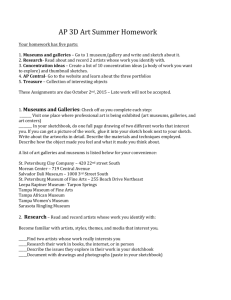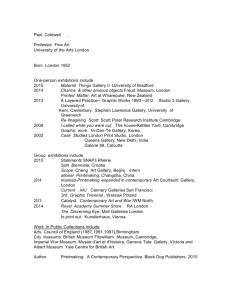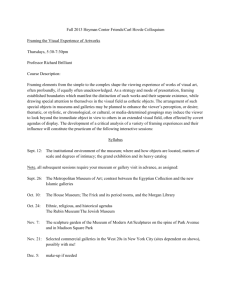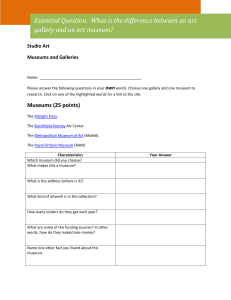PROJECT OUTLINE:
advertisement
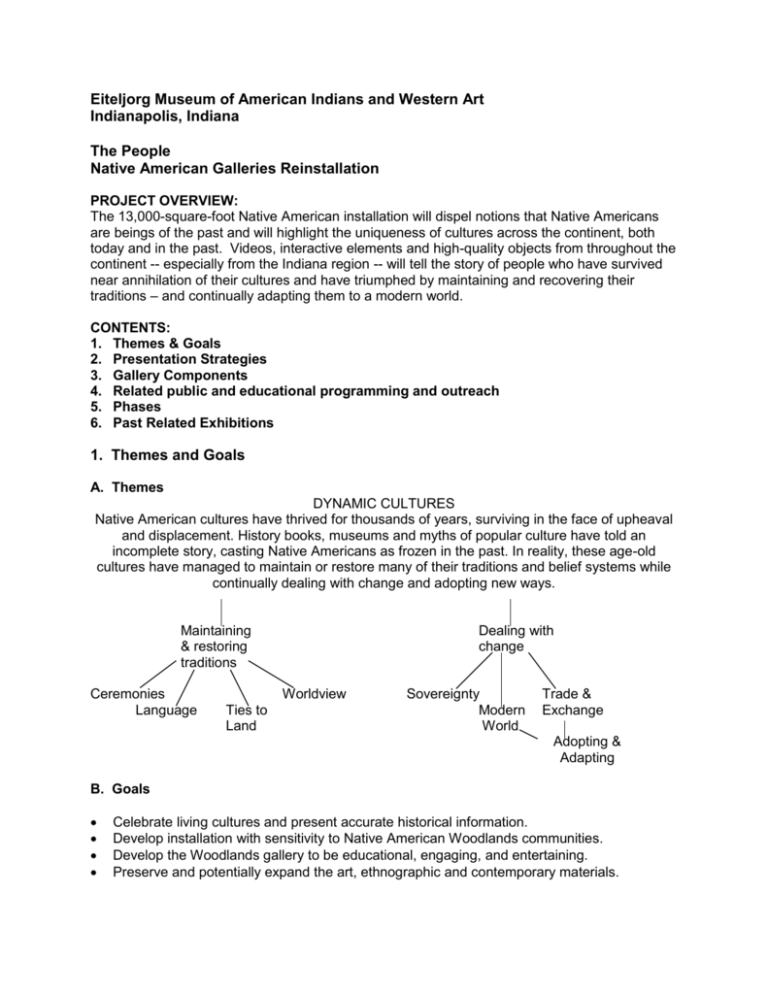
Eiteljorg Museum of American Indians and Western Art Indianapolis, Indiana The People Native American Galleries Reinstallation PROJECT OVERVIEW: The 13,000-square-foot Native American installation will dispel notions that Native Americans are beings of the past and will highlight the uniqueness of cultures across the continent, both today and in the past. Videos, interactive elements and high-quality objects from throughout the continent -- especially from the Indiana region -- will tell the story of people who have survived near annihilation of their cultures and have triumphed by maintaining and recovering their traditions – and continually adapting them to a modern world. CONTENTS: 1. Themes & Goals 2. Presentation Strategies 3. Gallery Components 4. Related public and educational programming and outreach 5. Phases 6. Past Related Exhibitions 1. Themes and Goals A. Themes DYNAMIC CULTURES Native American cultures have thrived for thousands of years, surviving in the face of upheaval and displacement. History books, museums and myths of popular culture have told an incomplete story, casting Native Americans as frozen in the past. In reality, these age-old cultures have managed to maintain or restore many of their traditions and belief systems while continually dealing with change and adopting new ways. Maintaining & restoring traditions Ceremonies Language Dealing with change Worldview Ties to Land Sovereignty Modern World Trade & Exchange Adopting & Adapting B. Goals Celebrate living cultures and present accurate historical information. Develop installation with sensitivity to Native American Woodlands communities. Develop the Woodlands gallery to be educational, engaging, and entertaining. Preserve and potentially expand the art, ethnographic and contemporary materials. Develop services and products for the school community, families and life-long learners that help establish the museum as a community resource for learning about regional Woodlands art, history, culture and contemporary issues. 2. Presentation Strategies A. 1st Person Voice The galleries will utilize 1st person voice, attributed to specific Native Americans when possible, in order to present topics from a Native American viewpoint. Use of first-person voice will emphasize the museum’s goal to present accurate information that is sensitive to Native American issues and will also serve to highlight living cultures and individuals within those cultures instead of the standard curatorial/anthropological viewpoint utilized in the past. B. Use of audio-visual technology Audio-visual technology will be a critical medium for giving the visitor a multi-sensory experience that will tie to the themes and will expand on both historical and contemporary objects. These technological elements will focus on contemporary artists who make objects that can be traced back to historical objects, connecting the stories and traditions that are so important to specific cultures. This will enable visitors to learn from artists, children and elders about Native peoples. Introductory video to the Native American galleries The introductory video to the galleries, presented in a sit-down theater, will provide visitors with an overview of the themes outlined above. Just as the museum itself is a gathering place for cross-cultural sharing, the introductory film will utilize the Eiteljorg Museum’s annual Indian Market as a contemporary example of the coming together of cultures for trade and exchange. By mixing historical examples with video of contemporary Native peoples engaged in the production and trade of artwork as well as in dance, food preparation and social engagement, the video will present the rich and diverse heritage of Native cultures up to the present. Artist vignettes Artist video vignettes will follow artists from the introductory video to their home environment and let visitors watch the creation of a particular object (which will be purchased to be on view in the museum) from preparation, through creation, to trade. It would highlight the artists’ cultural backgrounds, their teachers and traditions and ultimately, their worldview. Possible documentary: Together, the above components would make a documentary of the diversity of Native peoples across North America and provide an intimate insight into the making and creating of specific Native American artworks. The documentary would explore in depth the worldviews of several individuals, while illustrating a commonality among Native peoples, yet with diversity within it. C. Use of graphics The galleries will provide a sense of people and place through mural-size historical and contemporary photographs and painting reproductions. These will highlight rich images of the environment as well as people from the focus communities. Smaller graphics in the timelines and within the casework will provide a rich sense of people. 3. Gallery Components A. Artifacts & Casework Built-in casework will highlight high-quality objects relating to identity, daily life and continuing culture ranging in date from the 1700s to the present. These object-rich cases will be complete with glass front-accessible lockable doors and interior lighting systems. By using motion-sensitive timed lighting and appropriate light levels, we will be able to meet each object’s conservation requirements. In addition, cases will incorporate an interior rail system for mounting text and photographic panels. B. Timeline Visual historical timelines will focus on the issue of sovereignty of Native cultures. Objects or images relating to the date(s) highlighted will provide a visual record of the time period, along with quotes relating to dates. The timeline will focus on the historical period up to the present, with some reference to pre-contact periods. C. Maps Base maps that show Native occupancy and land prior to European contact, overlaid with changes in the land and ownership throughout the historical period, will provide a sense of the upheaval and displacement experienced by Native Americans. D. Interactives Tying in to the main themes, interactives will focus on cultural traditions that have survived and that utilize modern conveniences. In addition, interactives will give visitors a sense of the cultural diversity within a type of art, such as basketry. E. Demonstration/gathering areas Three to four demonstration/gathering areas throughout the galleries will provide opportunities for cultural interpretation, artists in residence and museum guides to work with groups of 15 to –20, as well as activities for visitors when the space is unmediated. 4. Related public and educational programming and outreach A. Teacher Resource Guide and related workshops A multi-phased Native American resource guide for teachers will accompany each phase of the museum’s reinstallation of the Native American galleries. Plans are to provide each Indiana elementary and middle school with a copy of the guide and provide it online for teachers to download. Teachers and others will be able to purchase their own copy of the guide in the museum store at cost. The guide will be tied to academic standards of the Indiana State Department of Education and developed with input from our Native American advisory councils, our education council and teacher advisors. When possible, Native American educators will be contracted to provide the lesson plans and additional text so that it truly has a Native American perspective. Its purpose is to: Support educational standards for grades 3, 4, 5 and 8: Lesson plans (tied to Indiana academic standards) in social studies, language arts and visual arts Reproducible images/handouts Additional resources Opportunities to tie museum visit to school curriculum through gallery activities Access to teacher training workshops. Integrate with the Eiteljorg Museum Web site resources for teachers, students, families and lifelong learners: online access to guide and pre-/post-visit activities through. online access to tour, distance learning and program information. Potential access to online tour for students. Integrate with Eiteljorg Museum distance learning programs and activities. Engage interest in regional resources in the four-state area. B. Gallery programs Goals: To enliven the Native American gallery through demonstrations and workshops involving Native American artists. To develop and enhance the museum’s role as a force for preserving and teaching endangered Native American handcrafts particularly those of the indigenous Midwestern Woodlands peoples. To bring contemporary Native American artists and their work to new audiences and to enhance the image of Native Americans as contemporary people with dynamic, living cultures. Through artists in residence, innovative interpretive programs, master artist classes and community outreach, the museum will extend the gallery’s dynamic presentation of first-person Native American voice. Artists in residence: Native American artists will be invited to the museum for extended visits to teach traditional Native American handcrafts, contemporary art, storytelling, theater and film through example and hands-on workshops Cultural interpreters: Native American cultural specialists and museum staff will train selected local Native American youth in presenting cultural information to the public and in leading tours of the galleries. Master artist classes: Where appropriate and where funding is available for artists and scholarships, Native American artists would be invited to attend master classes that would focus on teaching an endangered handcraft to a new generation. Community outreach: Community outreach utilizing artists in residence and cultural interpreters will help museum audiences see Native peoples as part of living cultures that struggle with the same contemporary issues as others. C. Education Center Classes The Eiteljorg’s new Nina Mason Pulliam Education Center is scheduled to open in the fall of 2003 and will offer 3,100 square feet of space, including classrooms, a media center and handson collections space. The space and state-of-the-art technology will allow the museum to greatly expand its educational and public programming. Once the center is open, classes targeting the Native American galleries will enhance student and visitor experiences of our Native American galleries. 5. Phases The reinstallation of our Native American galleries will be a multi-phased project: Phase I will incorporate a new permanent gallery focusing on the Native Americans of the Indiana region, including the Miami, the Potawatomi and the Delaware. This gallery will serve as the prototype for the rest of the reinstallation project. Completion date: June 2002. Phase II & III will focus on the reinstallation our North American survey of Native Americans and will include a small rotating gallery focusing on Indians in the 21st Century. Completion date: As funding becomes available. 6. Past Related Exhibitions: The Eiteljorg is earning a reputation for presenting exhibitions and programs that explore in new ways the art, history and cultures of Native Americans and the American West, giving a more complete understanding of the West and Native America. These programs incorporate art objects and exhibit strategies that help convey personal stories and historical information: In the Presence of the Past: The Miami Indians of Indiana (1997-1998), a personal study of Indiana’s first people; Cowboys, Settlers and Soldiers: African Americans in the West (1999), stories of 24 African Americans who helped settle the West; The Eiteljorg Fellowship for Native American Fine Art, a biennial program honoring outstanding Native American fine artists; From One Hand to Another: Native American Treasures from The Children’s Museum, a Museum Loan Network-funded exhibition/installation that examines how cultural values are transmitted from one generation to another.

